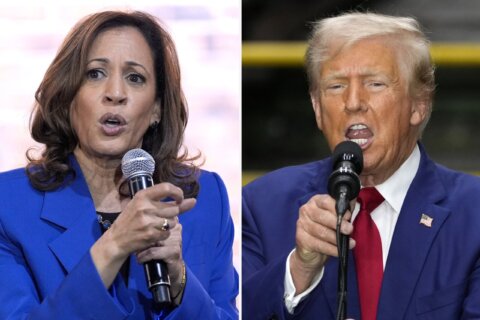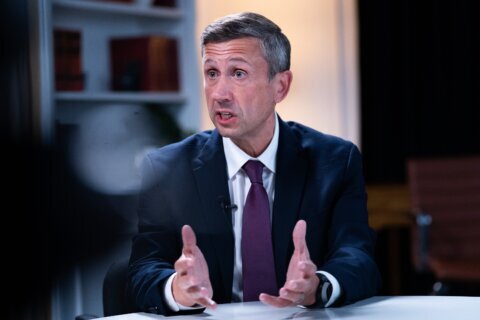
Donald Trump has been in the political limelight for almost a decade and it’s continually been a challenge for the media to cover him.
The former president has referred to national media networks, such as ABC News and CBS, as “fake news” organizations and has spent large portions of news conferences and rallies criticizing how the media covers him.
Also, there has been the “sanewashing” coverage of him in which the media would normalize some of the wild and controversial things he said.
University of Maryland journalism professor Tom Rosenstiel joined Dimitri Sotis on WTOP on Thursday to discuss how the press should cover Trump.
Listen to the full interview below or read the transcript. The transcript has been lightly edited for clarity.
Dimitri Sotis: We’ve had almost 10 years to try to figure out, as a collective group of news organizations how to cover Donald Trump. Have we ever quite cracked the code or figured out the formula?
Tom Rosenstiel: I’d say no. The question of how do you cover, as a fact-based profession, as journalists, how do you cover someone who has no interest in facts and thinks that the truth is something that you can invent if you repeat it often enough. He bedevils us and, add to that, he demonizes us. So how do you cover someone fairly who has called you the enemy of the people and who doesn’t believe in the basic currency by which you operate, which is facts and evidence.
Dimitri Sotis: Something tells me, though, you’re not about to tell us all to throw up our hands and stop trying. I wanted to kind of take a look at a couple of different ways that this has manifested itself recently. Every unusual thing that he said, from talking about an enemy within to talking about what the late golfer Arnold Palmer looked like as he was showering with other pros in the locker room, that’s been covered. It may just be a consequence of getting so close to November 5th. But not too long ago, you could find an article somewhere that just talked about Donald Trump promoting school vouchers, completely ignoring 90 minutes of a rally where he said all kinds of unusual things.
Tom Rosenstiel: Yeah. I mean, the first decision you make as a news organization, of course, about a particular event, is do you cover it? And then the question is how? You know in 2015 when Trump was a candidate who actually people doubted would win the nomination, he got a lot of free coverage that was pretty easy because he was discounted. The press, you know, blessed him by covering him uncritically as a kind of entertainment. Then the question, you know, becomes once he’s the nominee of the party as he is now, the question of whether you cover him is predetermined. You have to cover him. He is one election away from reelection.
So then the question is, how do you cover him? And I think the press, as his own behavior has become more erratic as the election has gone on, I think that the press has made a collective decision to cover him more closely. Don’t avoid the idea of amplifying the things he says. Instead, actually keep the camera going, make the sound bites longer, don’t cleanse or filter him because people generally know what he’s like, but to know how he’s changing or whether his behavior has become even more erratic or more dramatic, you need to see him in full.
Dimitri Sotis: Hindsight is 20/20, but should this not have been put into effect long ago?
Tom Rosenstiel: Well, I mean, it’s a harder calculation to make when he’s running against several other people in a primary, and he’s not yet the nominee because you have the calculation that if you make the mistake that the press made in 2015 of overcovering him and covering him far more than any other candidate, you’re giving him oxygen. And it’s essentially unfair to the other candidates who are less well known, and you know, need some recognition to allow voters to evaluate them.
So the kind of microscopic coverage that we’re seeing of Trump now would have been unfair to his rival candidates during the primaries a year ago who had very little name recognition and needed to introduce themselves and let voters get a sense of who they were and decide whether they might want any one of those candidates as an alternative to Trump. Once he’s the nominee, it becomes a much simpler calculation. But I think the kind of microscopic coverage that we’re seeing now actually would have been unfair to his advantage and unfair to the disadvantage of his rivals during the primaries.
Dimitri Sotis: What do you make of this exact term that’s come up just in recent weeks? “Sane-washing,” as they call it. It’s exactly what we’ve been discussing now that if you just grab one sound bite or one quote, It doesn’t give the full picture of what this candidate is all about.
Tom Rosenstiel: Yeah. I think that the term, while it’s caught on and as some kind of an idea that’s out there in the air, I don’t think it’s a real thing in one sense and that the people who use the term sane-washing don’t like Trump, and they would like more of the United States, more Americans, to think that Trump was dangerous, erratic, unstable and insane in effect. The term “sane-washing” suggests he’s not sane. They would like the rest of the country to see that the way they see it and they think the press is the only vehicle that can do that. So they blame the press, in a sense, out of frustration, for the fact that 48% or 49% of the country have approved of Trump in surveys in different metrics.
It’s inexplicable to them, and they think if people only saw him the way they did and that’s the press’s fault that they don’t. So they’re looking for ways to blame the press, and to some extent, they’re working the refs. The criticism, however, I think did help journalists evaluate, “OK, maybe we actually need to cover him more, not less.” That by covering some of this behavior as if it’s just another campaign stop, we’re in a sense normalizing what we see when we’re there as really crazy.
And so maybe the way they do that is to lengthen the sound bites, to show five-minute sections of video and to describe these events, which have become so familiar to us as journalists covering them that were kind of a nerd to some of it, convey what it’s like in a in a larger sense almost on a daily basis. So although the term sane-washing describes something that I think really never was happening or was describing a frustration that liberals tend to have about the coverage of Trump.
The term did cause some reflection on the part of the press, which has led to in the late days, better coverage. Would that coverage have made any difference if the press had done it five, six weeks earlier? No. I mean, you know, we have a very small number of Americans who are undecided who they’re going to vote for, but they’re not really undecided about what they think of Trump. You could not have a more familiar character in American politics.
Dimitri Sotis: In addition to all of the other things he said, he has talked about punishing journalists. If indeed, next year Donald Trump is back in the Oval Office, what major challenges did that pose? It’s not just that he would argue with us as we try to cover him, but he’s making threats of putting some of us behind bars.
Tom Rosenstiel: Yeah, I don’t know. First, we don’t know whether that’s an idle threat or a consistent threat or a real threat. It’s certainly dangerous talk. It is consistent with the demonization of the press and the belittling of the First Amendment that he’s engaged in from the beginning of his presidency in 2017. It is frightening. It’s also not clear whether the courts would allow the things that he wants to do, and it may well be that trying to criminalize the behavior of news organizations that you don’t like versus the ones that you do like may be a bridge too far that even his supporters will understand that’s unconstitutional.
Dimitri Sotis: Doesn’t sound like you see that kind of thing happening here in America, even if a lot of other things change?
Tom Rosenstiel: You know, the challenge with Trump is that journalists have always staked their expertise in the idea that the future is like the past, only more so, and Trump threw that concept out the window. After Trump’s election, the future was no longer like the past, only more so. So I am not confident about any prediction that any of us could make about what Trump would do as president and certainly what he would do as it regards to the press.
Get breaking news and daily headlines delivered to your email inbox by signing up here.
© 2024 WTOP. All Rights Reserved. This website is not intended for users located within the European Economic Area.






